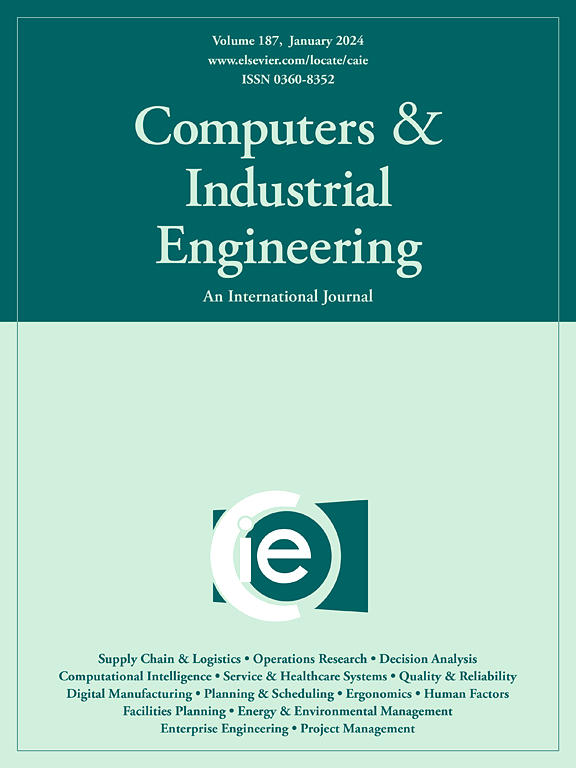通过配备精益工具和随机规划的方法,揭示水产养殖业供应链弹性的风险缓解策略
IF 6.7
1区 工程技术
Q1 COMPUTER SCIENCE, INTERDISCIPLINARY APPLICATIONS
引用次数: 0
摘要
土耳其非常重视海产品,尤其是对全球粮食安全至关重要的鲑鱼,大量投资推动了黑海地区土耳其鲑鱼养殖的增长。尽管盈利,但该行业面临着挑战,包括供应链容易受到内部和外部中断的影响,从而导致连锁反应。该行业最重大的挑战之一是鱼泄漏,它直接影响交货时间和客户满意度水平。通过特别关注暗流和风暴因素,本研究提出了一种全面的方法,采用持续改进周期来管理这一挑战。该方法涉及一种新的基于场景的两阶段随机规划模型,其目标是最小化预期总成本。该模型是针对运输问题制定的,解决水产养殖业内的鱼类逃逸问题,以建立一个有弹性的供应链结构。它还探讨了与各种可靠性水平相关的精益实施的全面性,代表决策者的风险倾向。此外,建立了实验设计(DoE)设置,以审查控制因素及其相互作用对结果的影响。在进行计算分析、考虑因素、精益成熟度水平和精益实施的全面性对结果的影响之后,在风险缓解战略的背景下提供了有价值的管理见解。调查结果表明,在发生严重中断的情况下,可以通过主要由精益工具推动的基于持续改进的方法,在减轻风险方面取得重大进展。本文章由计算机程序翻译,如有差异,请以英文原文为准。
Revealing risk mitigation strategies for supply chain resilience in aquaculture industry through a methodology equipped with lean tools and stochastic programming
With a notable focus on seafood, especially salmon, which is crucial for global food security, substantial investments have fueled the growth of Turkish salmon farming in the Black Sea region. Despite being profitable, the industry faces challenges, including supply chain vulnerabilities to internal and external disruptions, leading to a ripple effect. One of the most significant challenges in the sector is fish escapes, which directly impact lead time and customer satisfaction levels. By specifically focusing on undercurrent and storm factors, this study proposes a comprehensive methodology, adopting a continuous improvement cycle to manage this challenge. This methodology involves a novel scenario-based two-stage stochastic programming model with the objective of minimizing the expected overall cost. The model is formulated for the transportation problem, addressing fish escapes within the aquaculture industry to establish a resilient supply chain structure. It also explores the comprehensiveness of lean implementation associated with various reliability levels, representing the decision-maker’s risk propensity. Moreover, a design of experiment (DoE) setting is established to scrutinize the impact of controlled factors and their interactions on the outcomes. After conducting computational analysis, considering the impact of factors, lean maturity levels, and the comprehensiveness of lean implementation on the results, valuable managerial insights are provided within the context of risk mitigation strategies. The findings indicate that in the event of severe disruptions, significant improvements in risk mitigation can be achieved through the continuous improvement-based methodology, primarily driven by lean tools.
求助全文
通过发布文献求助,成功后即可免费获取论文全文。
去求助
来源期刊

Computers & Industrial Engineering
工程技术-工程:工业
CiteScore
12.70
自引率
12.70%
发文量
794
审稿时长
10.6 months
期刊介绍:
Computers & Industrial Engineering (CAIE) is dedicated to researchers, educators, and practitioners in industrial engineering and related fields. Pioneering the integration of computers in research, education, and practice, industrial engineering has evolved to make computers and electronic communication integral to its domain. CAIE publishes original contributions focusing on the development of novel computerized methodologies to address industrial engineering problems. It also highlights the applications of these methodologies to issues within the broader industrial engineering and associated communities. The journal actively encourages submissions that push the boundaries of fundamental theories and concepts in industrial engineering techniques.
 求助内容:
求助内容: 应助结果提醒方式:
应助结果提醒方式:


